20 Birds with Black Heads (with Pictures)
Last Updated on
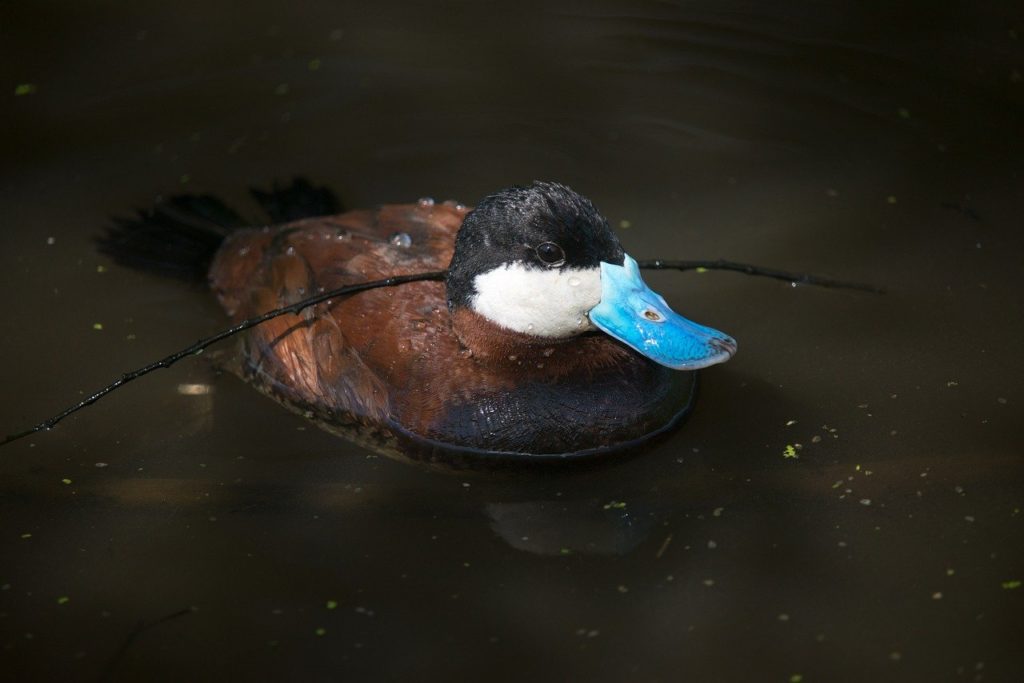
Birdwatching is a peaceful pastime for many. Still, birders will know the utter frustration of seeing a bird for a fleeting moment and not being able to identify it. Instead, we often catch a glimpse of a prominent feature and do our best research to try and identify it later at home.
A black-colored head is a common feature for many North American birds, so if you catch a glimpse of a black-headed bird, check out our list of common birds with black heads to help you identify it.

How to Identify a Bird
Many bird species possess common qualities. You’ll see many birds on this list today are very different despite all having black heads. To help you identify a bird, use four main observations to narrow down your search:
- Color and pattern
- Size and shape
- Habitat
- Behavior
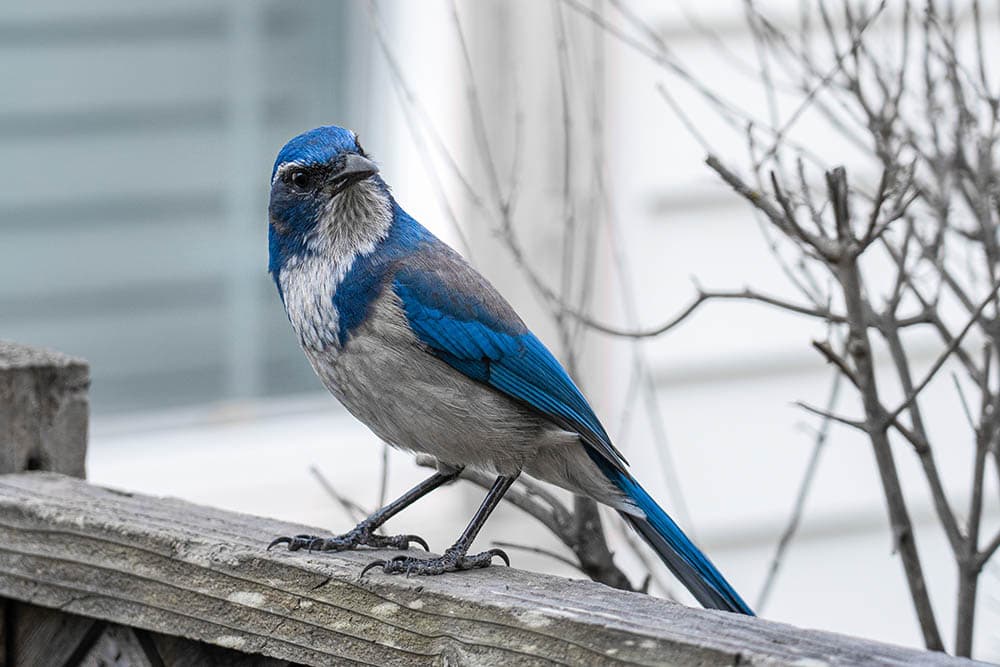
Colors and Patterns
Besides the black head, does this bird have any other distinguishing colors? Bright colors like reds, oranges, and yellows are easily spotted from a distance or within a brief glimpse. Muted colors such as grays and browns take a closer inspection.
How the colors are distributed across the bird’s bodies makes a big difference in identification. Look for colors on the following areas:
- Head
- Back
- Breast
- Wing (including wing bars)
- Tails
Size and Shape
There is a big difference between the tiny Carolina chickadee and an enormous Canada goose, right? This is an extreme example, but each species will have different sizes and body shapes that can help you to identify its species.
Also, take note of their beak shape and size.
Habitat
Some bird species can look almost identical but occupy entirely different habitats. The area where you find a bird will considerably influence identifying it. The range can differ between similar species, such as the tufted titmouse or the black-crested titmouse.
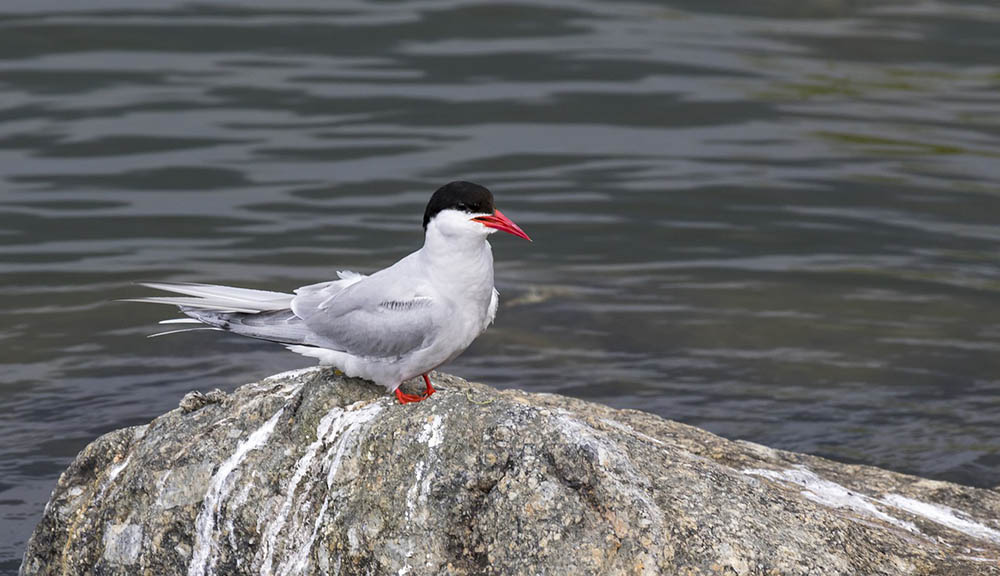
Behavior
Each bird species has evolved to adapt to specific habitats and diets. Their behaviors will vary based on these factors. Observe how the bird flies, forages, and vocalizes to help narrow down the identification process.

The 20 Birds with Black Heads in North America
1. Rose-Breasted Grosbeak

| Scientific name | Pheucticus ludovicianus |
| Distribution | Northern America, winters in South America |
| Habitat | Deciduous forests, orchards, groves |
A breeding adult male rose-breasted grosbeak will usually be black and white with a bright red triangle on the breast. Females, nonbreeding males, and immatures are streaky brown with bald heads.
Females and young males look similar to the black-headed grosbeak but are differentiated by the area they inhabit. They have robin-like calls and sweet songs and often visit backyard feeders.
2. Black Phoebe

| Scientific name | Sayornis nigricans |
| Distribution | Southwestern United States |
| Habitat | Near water sources, canyons, farmland, urban areas |
Black phoebes are familiar sights in areas with vast water sources such as streams and ponds. These birds are rarely found away from water as they rely on aquatic insects for sustenance.
They are often seen perched near water, wagging their tails. They use keen eyesight to spot insects above the water and swoop across streams to hunt them. When aerial insects are limited in cooler weather, they may take insects from the ground.
3. Scott’s Oriole

| Scientific name | Icterus parisorum |
| Distribution | Southwest, winter in Arizona and California |
| Habitat | Oak woods, canyons, open grassland |
Scott’s oriole is often the first bird to begin singing in the day, starting well before sunrise. Despite their vocal nature, they are relatively uncommon and aren’t seen often in flocks like other orioles.
Foraging is slow and quiet in treetops, where they hop around branches searching for nectar and insects. They closely correlate with the yucca plant and will be abundant where yuccas exist. They use the yucca as a food source and nesting sites.
4. Black-Headed Grosbeak

| Scientific name | Pheucticus melanocephalus |
| Distribution | Eastern North America |
| Habitat | Deciduous and mixed woods |
Black-headed grosbeaks are one of the few birds that can eat monarch butterflies despite the toxic chemicals they contain. Males also resemble the colors of a monarch butterfly cloaked in warm orange.
As their name suggests, they are donned with a back head that extends down their wings, interrupted by white wing bars. As usual, females are more muted and mostly brown with orange hints on their underbelly.
5. Black Tern

| Scientific name | Chlidonias niger |
| Distribution | Widespread North America |
| Habitat | Marshes, lakes, coast |
Many tern species are identifiable by their black-capped heads. The black tern is a little more distinct with the black coloration extending down the breast and the underbelly, contrasted with light silver wings and tail.
Black terns rely on wetland marshes for nesting, and the loss of these habitats has caused a decline in populations. In the winter, they grace coastal areas and fit in seamlessly with other sea birds.
6. Barn Swallow

| Scientific name | Hirundo rustica |
| Distribution | Widespread across North America and the globally |
| Habitat | Open land, farms, fields, marshes, lakes |
Most people, whether bird enthusiasts or not, are accustomed to the sight of a barn swallow. These widespread birds occupy a range of habitats that overlap with human settlements. It’s unusual to find a barn swallow nesting in a natural area. They prefer artificial structures such as barns, bridges, or garages.
They are often welcome additions around farms and homes for their favored diet, insects. They keep small bugs at bay by swooping feeding.
7. Ancient Murrelet

| Scientific name | Synthliboramphus antiquus |
| Distribution | West coast of North America |
| Habitat | Open ocean, sounds, bays |
This sea-based diving bird is standard on the western coast. However, their population declines due to introduced mammals (foxes and raccoons) on their nesting islands.
These busy body birds spent the day diving in the sea, searching for fish and crustaceans. They are relatively active in their island colonies at night, where they socialize and defend nesting sites.
Their small bodies are stocky and resemble the shape of penguins.
8. Carolina Chickadee
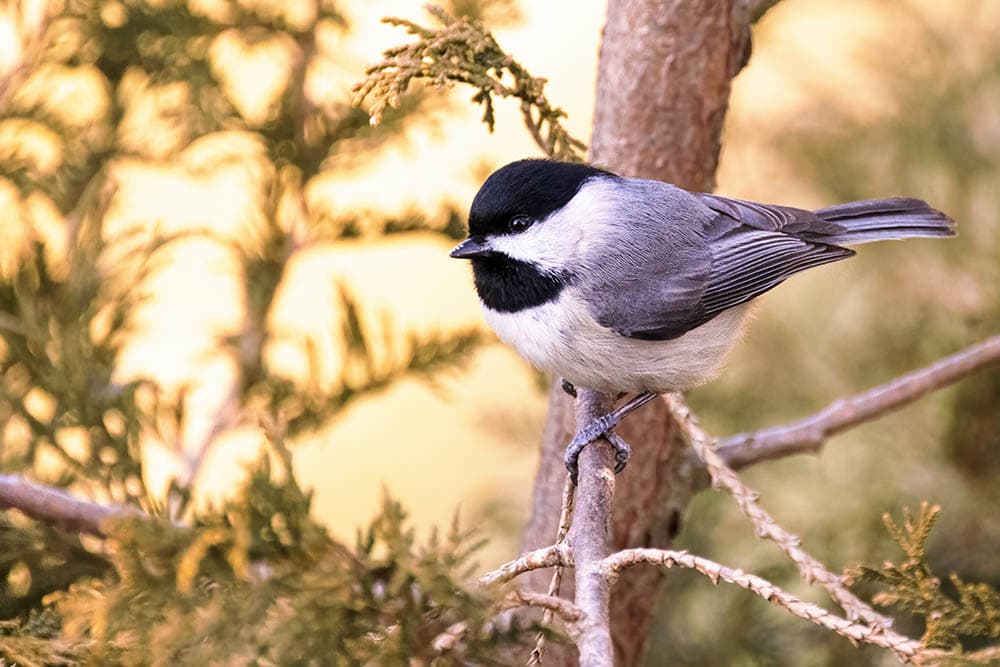
| Scientific name | Poecile carolinensis |
| Distribution | Mid, Eastern, and Southern United States |
| Habitat | Mixed woods, groves |
The Carolina chickadee is a small, sweet bird. While it is common in mild climates of the southeast, it does not visit backyard feeders commonly. However, they are enticed by sunflower seeds.
It’s thought this species mate for life, forming pairs in winter flocks and remaining together to nest over spring and summer. Both parents build the nest and care for the young, co-parenting at its finest!
9. Canada Goose

| Scientific name | Branta canadensis |
| Distribution | Widespread in North America |
| Habitat | Water sources: lakes, ponds, bays |
Vastly different from some of the petite forest birds, but black-headed all the same. The enormous Canada goose is widespread across all North America. The majority breed in Canada and migrate as far south as Mexico for the winter.
Some populations stay in mid-United States all year round and are common across farms, fields, and even urban areas. Their diet is vague and consists of basic plant matter, so they easily adapt to diverse habitats.
10. Black-billed Magpie

| Scientific name | Pica hudsonia |
| Distribution | Northwestern North America |
| Habitat | Farms, suburbs, groves |
Despite being excellent fliers, the black-billed magpie spends most of its time foraging by walking around on the ground. They are agile with their beak, which they use to manipulate items, searching for food.
This species impacts farmland by damaging crops and was extensively hunted in the 20th century. Even so, they remain widespread. Their adaptability and intelligence offer them an edge for survival.
11. Black-crested Titmouse
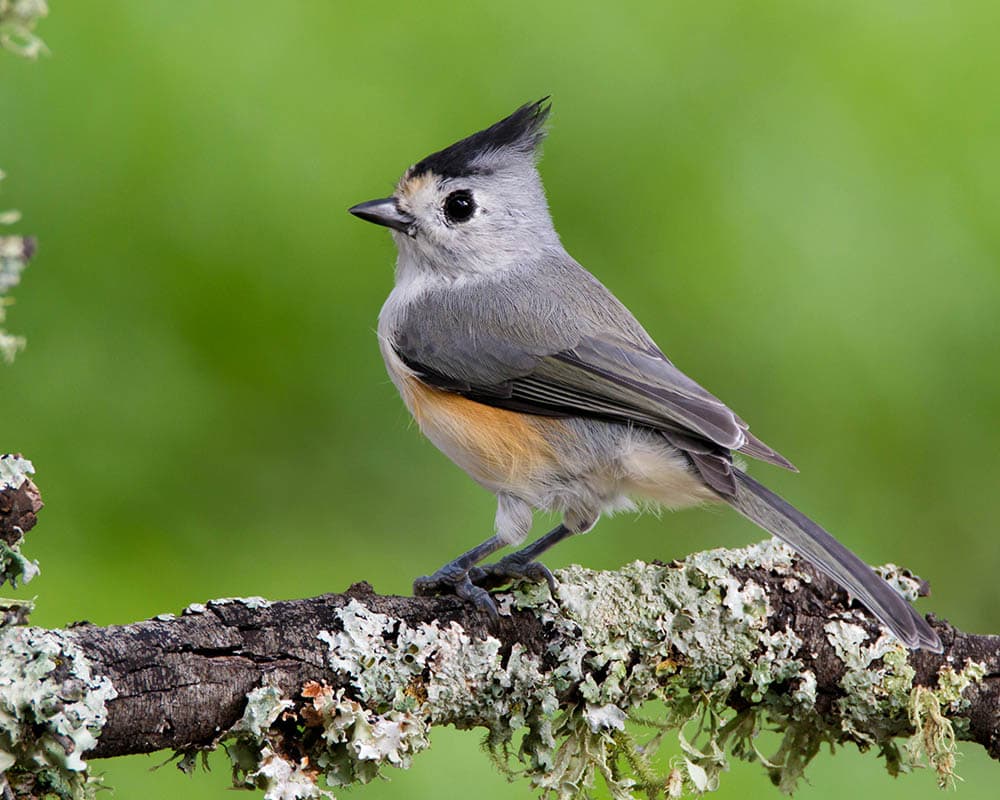
| Scientific name | Baeolophus atricristatus |
| Distribution | Southern Texas and Northern Mexico |
| Habitat | Woods, groves, brushlands |
The black-crested titmouse closely resembles the more common tufted titmouse. It was considered a subspecies but has since been redefined as a close relation. Their appearance is very similar, except the black-crested titmouse has a distinct back streak on its crest.
The two species overlap in central Texas, where they often interbred, creating hybrids with a dulled gray crest.
12. American Coot

| Scientific name | Fulica americana |
| Distribution | Widespread North America |
| Habitat | Lakes, marshes, ponds, bays |
The American coot behaves much like duck species, walking about the shore and wading in water sources. They found often in human-inhabited areas such as golf courses and parks. This is surprising, considering they are related to the famously elusive rail family.
The coot is distinguished by its bright white beak, a stark contrast to its black head. The top of the beak has a red patch, flanked by bright red eyes.
13. Barrow’s Goldeneye

| Scientific name | Bucephala islandica |
| Distribution | Northeastern United States, Eastern Canada, and Iceland |
| Habitat | Ponds, lakes, rivers, coast |
As their name states, the males of these striking ducks possess stunning gold eyes on top of their iridescent black colored heads. This gorgeous look, coupled with elaborate and communal courtship dances, attracts females for mating.
Females select their nest site and often return to the same spot yearly. They primarily breed in Canada and Alaska, migrating into the Northwestern United States for the winter.
14. American Goldfinch

| Scientific name | Spinus tristis |
| Distribution | Widespread United States, Southern Canada, and Northern Mexico |
| Habitat | Open woods, roadsides |
The American goldfinch is a common bird across the country. Females are a muted brown with yellow undertones, while males are brilliant yellow and adorned with back heads and wings.
The goldfinch nests late in the season, with the nest still active in the thick of the summer months. This late nesting allows the goldfinch to take advantage of late summer food supplies and avoid the competition for spring and early summer seeds.
15. American Redstart

| Scientific name | Setophaga ruticilla |
| Distribution | Widespread United States and Canada |
| Habitat | Woods, groves |
This stunning warbler species are highly active fliers. Fluttering and flittering about in the trees, they hover and zip out to catch flying insects.
Below their blackened heads and back are patches of vivid orange that are on proud display as the redstart spreads its tail and wings. This high activity is not limited to foraging, and males can mate with multiple females and maintain 2–3 nests.
16. American Oystercatcher

| Scientific name | Haematopus palliatus |
| Distribution | Atlantic and Gulf coasts |
| Habitat | Tidal flats, beaches |
The American oystercatcher is a standard sight of the East Coast. Occupying coastal flats, the oystercatchers live up to their name, wading through mud, sand, and water to forage on mollusks.
The distinctive orange beak extends out from their black-cloaked head and can exhibit a powerful blow to the toughest of shellfish, cracking open oysters with ease. If populations are dense, these oystercatchers will form polyamorous bonds with one male and two females to raise a nest of chicks together.
17. Black-capped Chickadee
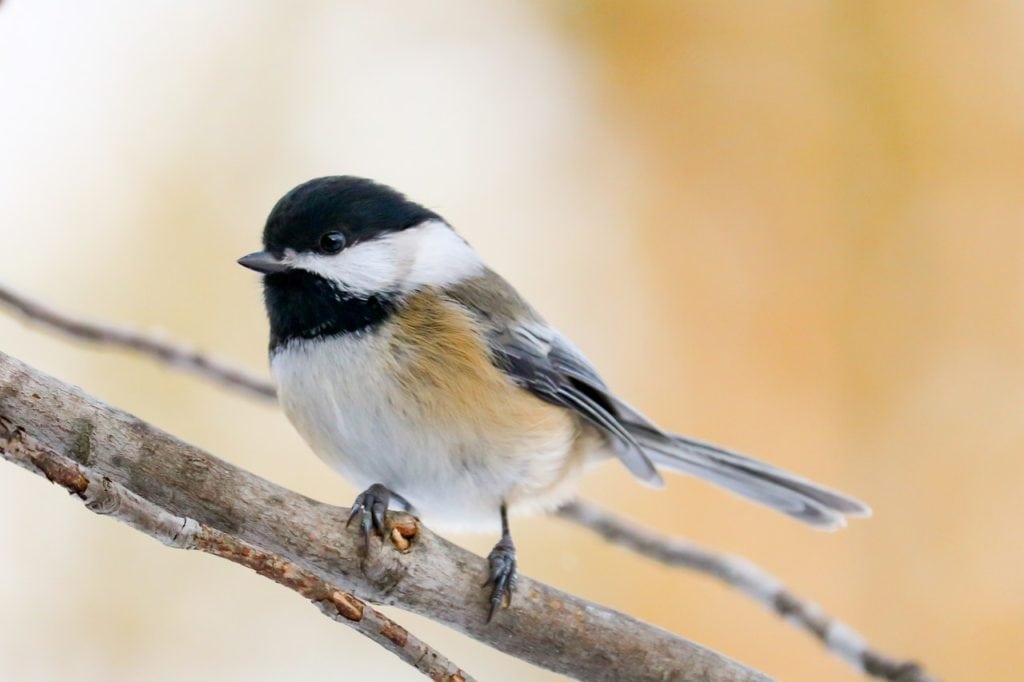
| Scientific name | Poecile atricapillus |
| Distribution | Northern United States, Canada, Alaska |
| Habitat | Mixed woods, groves, thickets, suburbs |
The black-capped chickadee is aptly named for their black head coloration. They are an active and vocal species, with their distinct “chick-a-dee” call. This little bird is a common addition to backyard feeders and is loved for its energetic nature.
They are cavity nesters, preferring to nest in tree cavities or woodpecker holes. They will take nicely to a cozy nesting box to keep them happy on your property.
18. Eastern Kingbird

| Scientific name | Tyrannus tyrannus |
| Distribution | Mid to Eastern United States and Canada |
| Habitat | Woods, farms, orchards, roadsides |
The eastern kingbird occupies habitats on wood edges, between dense forest and open space. They require the cover of trees for nesting but open-air for hunting insects. They are often found where human settlements meet the woods, such as on farmlands and by roadsides.
They prey on various insects, from small leafhoppers to larger grasshoppers, beetles, and bees. They supplement their diet with wild berries of the forest.
19. American Robin

| Scientific name | Turdus migratorius |
| Distribution | Widespread North America |
| Habitat | Suburbs, cities, farms, forests |
The American robin is an adaptable bird that persists across the entirety of North America, happily living well up into Canada and deep into Mexico. They are found in a variety of habitats, from cities to native forests.
Their diet is also varied depending on their habitat. They forage on the ground, eating anything they can, primarily fruits and insects.
20. Ruddy Duck

| Scientific name | Oxyura jamaicensis |
| Distribution | Widespread United States, Southwestern Canada, and North Mexico |
| Habitat | Ponds, lakes, marshes |
This water-based duck spends most of its time lounging on the water surface in between diving for food. In addition to aquatic insects, they nibble on nearby plants.
On land, they are awkward and slow, making them vulnerable. While they fly to migrate, during the settled seasons, they avoid flight. It takes a lot of energy to pump their wings to live their stocky bodies up.
Instead, they congregate on the water in large flocks, sometimes mingling with American coots.

Conclusion
We hope our list of black-headed birds helped you on your quest to identify the birds in your backyard or on your adventures in nature. The color black may seem plain to us, but black coloration shows a dazzling display of color rays for birds with a fundamentally different vision.
Featured Image Credit: purplerabbit, Pixabay
Table of Contents
- How to Identify a Bird
- The 20 Birds with Black Heads in North America
- 1. Rose-Breasted Grosbeak
- 2. Black Phoebe
- 3. Scott’s Oriole
- 4. Black-Headed Grosbeak
- 5. Black Tern
- 6. Barn Swallow
- 7. Ancient Murrelet
- 8. Carolina Chickadee
- 9. Canada Goose
- 10. Black-billed Magpie
- 11. Black-crested Titmouse
- 12. American Coot
- 13. Barrow’s Goldeneye
- 14. American Goldfinch
- 15. American Redstart
- 16. American Oystercatcher
- 17. Black-capped Chickadee
- 18. Eastern Kingbird
- 19. American Robin
- 20. Ruddy Duck
- Conclusion
About the Author Sophie Herlihy
After an early start in the veterinary industry and as a conservation educator at Disney’s Animal Kingdom in Florida, Sophie has since been a successful Zookeeper and Conservationist, specializing in native New Zealand species. When she isn't bird watching in native forests, she can be found with her husband on their sheep and beef station, far from civilization. Sophie enjoys her writing career as it provides opportunities to help and support pet owners of all kinds and getting to research and write about a broad range of topics. The only downside is the long list of strange searches in her internet history!
Related Articles:
Monocular vs Telescope: Differences Explained (With Pictures)
10 Types of Hummingbirds in Arkansas (With Pictures)
8 Types of Hummingbirds in Nebraska (With Pictures)
5 Types of Hummingbirds in Idaho (With Pictures)
3 Types of Hummingbirds in Mississippi (With Pictures)
8 Types of Hummingbirds in Kansas (With Pictures)
5 Types of Hummingbirds in West Virginia (With Pictures)
5 Types of Hummingbirds in Ohio (With Pictures)
